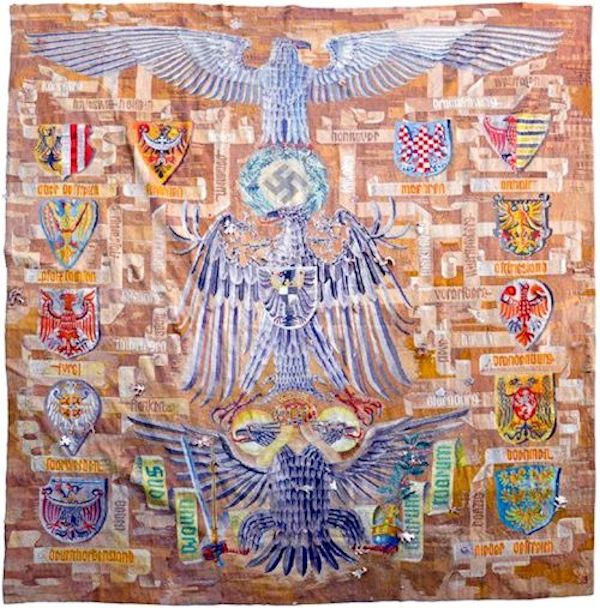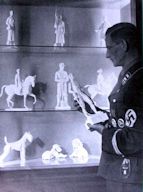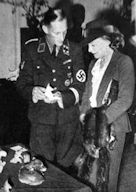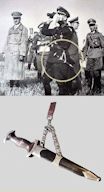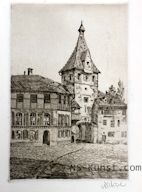|
|
|
|
“Der grosse Wandtappich” "The Great Tapestry" as Designed by Karl Diebitsch
|
|
|
“Der grosse Wandtappich” "The Great Tapestry" (Item ART 17-19a, SS-37-12)
 Oberführer Karl Diebitsch in Tegernsee, he intently listened as the professor spun the tales of the Allach porcelain legend that was so beloved to him. Diebitsch and his sister, Frau Elsie Seifert, told Johnston about the very beautiful and profoundly meaningful tapestries that Karl designed and she wove and constructed. These tapestries invariably told fascinating stories and they probed the mythos of the Teutonic past and proclaimed the glories of the National Socialist Third Reich. After the disastrous end of the Second World War, practically all of these wonderful art pieces disappeared into what seemed to be consummate oblivion. Professor Diebitsch seemed to feel that the tapestries were even more important to the National Socialist mythos than even the Allach porcelain and the Allach firm which he was, by the way, the founder of. At the time, Mr. Johnston was attempting to write a book on Allach porcelain and even more importantly he was gathering research on the tapestry of the Ahnenerbe Stiftung that hung in the offices of this wonderful heritage foundation based in Berlin. Professor Karl Diebitsch (January 1899–August 1985) was an artist personified, and he was the designer responsible for most of the regalia used by the
Oberführer Karl Diebitsch in Tegernsee, he intently listened as the professor spun the tales of the Allach porcelain legend that was so beloved to him. Diebitsch and his sister, Frau Elsie Seifert, told Johnston about the very beautiful and profoundly meaningful tapestries that Karl designed and she wove and constructed. These tapestries invariably told fascinating stories and they probed the mythos of the Teutonic past and proclaimed the glories of the National Socialist Third Reich. After the disastrous end of the Second World War, practically all of these wonderful art pieces disappeared into what seemed to be consummate oblivion. Professor Diebitsch seemed to feel that the tapestries were even more important to the National Socialist mythos than even the Allach porcelain and the Allach firm which he was, by the way, the founder of. At the time, Mr. Johnston was attempting to write a book on Allach porcelain and even more importantly he was gathering research on the tapestry of the Ahnenerbe Stiftung that hung in the offices of this wonderful heritage foundation based in Berlin. Professor Karl Diebitsch (January 1899–August 1985) was an artist personified, and he was the designer responsible for most of the regalia used by the  to include the officer’s model chained
to include the officer’s model chained  dagger and the well-known black
dagger and the well-known black  uniform and also the
uniform and also the  and police (Degen) ‘sword.’ It was he that did the original (entwurf) “designs” for all the most important tapestries that had
and police (Degen) ‘sword.’ It was he that did the original (entwurf) “designs” for all the most important tapestries that had  themes. He received one of the top art prizes at the House of German Art for his remarkable oil painting titled “Mutter” (“Mother”). He also designed many of the Reich’s postage stamps. When Mr. Johnston visited Prof. Diebitsch the learned man did at one point describe how he came to be the designer of these wonderful tapestries and told Mr. Johnston that it was his sister, Elsie Seifert, that actually wove these wonderful Wandteppiche (tapestries) along with an assistant by the name of Fraulein Stronika. Their firm in Munich, if we remember right, was called München-Gobelin. When listening to Dr. Diebitsch as he described his many tapestries, there came a time when Frau Seifert gave Mr. Johnston quite a few original pictures of tapestries that she had created from the designs of her illustrious and highly talented brother. One thing that utterly fascinated Mr. Johnston was a certain artwork that both the professor and his sister described as ‘Der grosse Wandteppich”–“The Great Tapestry.” This, it would seem, was the most important and most beautiful one that they had ever produced. It was thought to be hung outside or inside the main entrance to Adolf Hitler’s office in the Reich’s Chancellery in Berlin. It may, however, have hung in the House of German Art in Munich before going to its final destination and it’s also possible that it never got to the Reich’s Chancellery and we can, I suppose, be grateful that it did not, since the chancellery was entirely gutted and all contents burned by the vicious barbarian hordes that steamrolled over all of Berlin. Diebitsch and his sister were deservedly proud of all their tapestries, but this one was not only their pride and joy, but they thought it to be the most important one produced as it depicted German glory through the ages. Unfortunately, however, they did not have a single picture of it. Evidently there were numerous pictures of it in a special album that Frau Seifert
put together back in the era, but the album was stored at the offices of München-Gobelin Wandteppichwerk and the building was completely burned when allied bombs hit the display and storage units and destroyed many other precious artworks as well as this precious album. Mr. Johnston does remember that they told him this tapestry splendidly imparted the romance and history of the First, Second, and Third Reichs with symbols depicting all these empires and it had heraldic shields that included the Wappen or crests of several of the most important districts of the united Reich and the Holy Roman Empire. This remained stuck in Johnston’s mind over the years since his meeting with the professor and he often thought he would absolutely love to see a picture of this fabulous work of the weaver’s art. However, he figured and was sure he never would. Then! In May 2014, he saw to his absolute amazement suddenly that there was a giant tapestry that was featured in the auction offerings of Mohawk Arms in New York. The tapestry was being called the “N.S. Reichstag National Culture-Gobelin Tapestry.” The minimum bid was shown to be $25,000 and amazing that it did not bring it, but it definitely takes a person steeped in history and culture to appreciate a masterwork such as this. Unfortunately, I did not see it until after the auction was concluded and I couldn’t have handled it at that time in any case, even though my advisor, R. Johnston thought it to be definitely the most important purchase that could ever be accomplished and he was positive that here was the actual Grosse Wandteppich but he did not see it, either, until the auction was over. He was and is sure that it is most assuredly the very same “great tapestry” as described by Professor Diebitsch and Frau Seifert. Later, it came up again in another auction, but still it was with a very substantial starting bid. This was included in the “History Hunter Auction” where it was featured with a minimum bid of $25,000, but again we did not buy it. Why? Frankly, we knew it was worth a great deal more but the item came up again just when we had a crisis in hand. Then, miraculously, we finally had a last chance to buy it from the original owner at a time when we were able to do so with the welcome help of a well-known dealer in the field. This was one of the greatest highlights of any career in this particular line. The dealer knew that of all the collectors and dealers in this field that Germania International would be almost singular in a true appreciation and knowledge of such an important cultural item like this. In addition, of course, I personally can attribute this to the knowledge of R. Johnston, an astute historian of long standing. This piece is more culturally important than any of the wonderful tapestries dedicated to the astounding Third Reich mythos, and this one, Der grosse Wandteppich, is surely the most important of all!
themes. He received one of the top art prizes at the House of German Art for his remarkable oil painting titled “Mutter” (“Mother”). He also designed many of the Reich’s postage stamps. When Mr. Johnston visited Prof. Diebitsch the learned man did at one point describe how he came to be the designer of these wonderful tapestries and told Mr. Johnston that it was his sister, Elsie Seifert, that actually wove these wonderful Wandteppiche (tapestries) along with an assistant by the name of Fraulein Stronika. Their firm in Munich, if we remember right, was called München-Gobelin. When listening to Dr. Diebitsch as he described his many tapestries, there came a time when Frau Seifert gave Mr. Johnston quite a few original pictures of tapestries that she had created from the designs of her illustrious and highly talented brother. One thing that utterly fascinated Mr. Johnston was a certain artwork that both the professor and his sister described as ‘Der grosse Wandteppich”–“The Great Tapestry.” This, it would seem, was the most important and most beautiful one that they had ever produced. It was thought to be hung outside or inside the main entrance to Adolf Hitler’s office in the Reich’s Chancellery in Berlin. It may, however, have hung in the House of German Art in Munich before going to its final destination and it’s also possible that it never got to the Reich’s Chancellery and we can, I suppose, be grateful that it did not, since the chancellery was entirely gutted and all contents burned by the vicious barbarian hordes that steamrolled over all of Berlin. Diebitsch and his sister were deservedly proud of all their tapestries, but this one was not only their pride and joy, but they thought it to be the most important one produced as it depicted German glory through the ages. Unfortunately, however, they did not have a single picture of it. Evidently there were numerous pictures of it in a special album that Frau Seifert
put together back in the era, but the album was stored at the offices of München-Gobelin Wandteppichwerk and the building was completely burned when allied bombs hit the display and storage units and destroyed many other precious artworks as well as this precious album. Mr. Johnston does remember that they told him this tapestry splendidly imparted the romance and history of the First, Second, and Third Reichs with symbols depicting all these empires and it had heraldic shields that included the Wappen or crests of several of the most important districts of the united Reich and the Holy Roman Empire. This remained stuck in Johnston’s mind over the years since his meeting with the professor and he often thought he would absolutely love to see a picture of this fabulous work of the weaver’s art. However, he figured and was sure he never would. Then! In May 2014, he saw to his absolute amazement suddenly that there was a giant tapestry that was featured in the auction offerings of Mohawk Arms in New York. The tapestry was being called the “N.S. Reichstag National Culture-Gobelin Tapestry.” The minimum bid was shown to be $25,000 and amazing that it did not bring it, but it definitely takes a person steeped in history and culture to appreciate a masterwork such as this. Unfortunately, I did not see it until after the auction was concluded and I couldn’t have handled it at that time in any case, even though my advisor, R. Johnston thought it to be definitely the most important purchase that could ever be accomplished and he was positive that here was the actual Grosse Wandteppich but he did not see it, either, until the auction was over. He was and is sure that it is most assuredly the very same “great tapestry” as described by Professor Diebitsch and Frau Seifert. Later, it came up again in another auction, but still it was with a very substantial starting bid. This was included in the “History Hunter Auction” where it was featured with a minimum bid of $25,000, but again we did not buy it. Why? Frankly, we knew it was worth a great deal more but the item came up again just when we had a crisis in hand. Then, miraculously, we finally had a last chance to buy it from the original owner at a time when we were able to do so with the welcome help of a well-known dealer in the field. This was one of the greatest highlights of any career in this particular line. The dealer knew that of all the collectors and dealers in this field that Germania International would be almost singular in a true appreciation and knowledge of such an important cultural item like this. In addition, of course, I personally can attribute this to the knowledge of R. Johnston, an astute historian of long standing. This piece is more culturally important than any of the wonderful tapestries dedicated to the astounding Third Reich mythos, and this one, Der grosse Wandteppich, is surely the most important of all!The Tapestry
The tapestry as far back as we can locate its history was sold by famed militaria dealer Tony Oliver in England to the well-known U.S. collector Jerry Davis about 45 years ago and during the time Oliver owned it he very unfortunately rented it out to the MGM film studio to be used in probably the movie that was even worse than the filth and genocidal murder depicted in the film Inglourious Basterds or even Rage. Brad Pitt and Lee Marvin should be drawn and quartered along with the rest of the miscreants like Quentin Tarantino who produces such garbage. Luckily, the tapestry only revealed the very bottom of itself and only for a few seconds and its brilliant integrity was not soiled by its misuse in the rotten film The Dirty Dozen. The tapestry was sold by Oliver to Mr. Davis for $10,000.00 in 1968. It shows the three Germanic Reichs while employing the symbolic eagles of each of these empires. We know that the Third Reich was a continuum of the Carolingian Empire and that of course is the double-headed eagle depicted at the base of the work and then above this is the eagle of the Second Reich with the eagle of the Hohenzollern Prussian Monarchy in the middle of its chest. Then above and of course dominant, is the eagle and swastika of the Third Reich. All through the tapestry are enjoyning bands with the names of the various historical districts that made up these proud and noble Reichs, and along with this can be seen the shields of these districts all in full vibrant color. This is an entirely handwoven Gobelin (not applique). Germania International has long been specializing in important Third Reich tapestries. Please read about such works of art at ART 17-19 on our site. There you will see the OKW tapestry that we thought was the most important tapestry of Third Reich origin ever offered and it certainly is and was until miraculously we found this one. No tapestry could exceed this one!! Among the twelve embroidered shields there are included the Wappen arms of Über Oestreich, Schlesian, Anhalt, Pfalz, Sachen, Ostfriesland, Tyrol, Brandenburg, Franken, Boehmen, Deutschordensland, and Nieder Oestreich. Other areas are named on the series of connecting legends. All three eagles are embroidered in shades of silver/gray/black and are more pronounced with the addition of other colors emphasizing crown, sword, orb, and oak leaves. The background consists of subdued shades of brown/tan/dull gold-brown. The absolute utter magnitude of this monumental tribute to the glory of what was once Germany (pre-Merkel) is astounding and if it survives and someday if sanity prevails it will be considered a true treasure of the Western experience–“Deutschland, Deutschland über alles, über alles in der Welt.”
PRICE: For now it will be priced upon request. Serious inquiries only.


